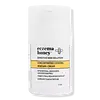What's inside
What's inside
 Key Ingredients
Key Ingredients

No key ingredients
 Benefits
Benefits

No benefits
 Concerns
Concerns

 Ingredients Side-by-side
Ingredients Side-by-side

Water
Skin ConditioningSqualane
EmollientC12-15 Alkyl Benzoate
AntimicrobialCaprylic/Capric Triglyceride
MaskingGlycerin
HumectantDimethicone
EmollientAloe Barbadensis Leaf Juice
Skin ConditioningButyrospermum Parkii Nut Extract
EmollientCetearyl Olivate
Sorbitan Olivate
EmulsifyingAvena Sativa Kernel Flour
AbrasiveCetearyl Alcohol
EmollientDicaprylyl Ether
EmollientSafflower Seed Oil Piperonyl Esters
Skin ConditioningDipotassium Glycyrrhizate
HumectantNiacinamide
SmoothingHoney
HumectantCetyl Palmitate
EmollientSorbitan Palmitate
EmulsifyingBakuchiol
AntimicrobialAdenosine
Skin ConditioningResveratrol
AntioxidantRetinal
Skin ConditioningCaprylyl Glycol
EmollientEthylhexylglycerin
Skin ConditioningHexylene Glycol
EmulsifyingEthylhexyl Palmitate
EmollientSilica Dimethyl Silylate
EmollientButylene Glycol
HumectantPentylene Glycol
Skin ConditioningSodium Hyaluronate
HumectantOlea Europaea Leaf Extract
PerfumingFructose
HumectantSymphytum Officinale Leaf Extract
Skin ConditioningBuddleja Davidii Meristem Cell Culture
Skin ConditioningCyperus Papyrus Leaf Cell Extract
AntioxidantCamellia Sinensis Leaf Extract
AntimicrobialSodium Hyaluronate Crosspolymer
HumectantSodium Palmitoyl Proline
Skin ConditioningNymphaea Alba Flower Extract
Skin ConditioningSea Water
HumectantLaminaria Digitata Extract
Skin ProtectingChlorella Vulgaris Extract
Skin ConditioningSaccharide Isomerate
HumectantPolyacrylamide
C13-14 Isoparaffin
EmollientLaureth-7
EmulsifyingTocopherol
AntioxidantXanthan Gum
EmulsifyingSodium Hydroxide
BufferingCitric Acid
BufferingDipropylene Glycol
HumectantPhenoxyethanol
PreservativeSodium Benzoate
MaskingPotassium Sorbate
PreservativeBenzoic Acid
MaskingWater, Squalane, C12-15 Alkyl Benzoate, Caprylic/Capric Triglyceride, Glycerin, Dimethicone, Aloe Barbadensis Leaf Juice, Butyrospermum Parkii Nut Extract, Cetearyl Olivate, Sorbitan Olivate, Avena Sativa Kernel Flour, Cetearyl Alcohol, Dicaprylyl Ether, Safflower Seed Oil Piperonyl Esters, Dipotassium Glycyrrhizate, Niacinamide, Honey, Cetyl Palmitate, Sorbitan Palmitate, Bakuchiol, Adenosine, Resveratrol, Retinal, Caprylyl Glycol, Ethylhexylglycerin, Hexylene Glycol, Ethylhexyl Palmitate, Silica Dimethyl Silylate, Butylene Glycol, Pentylene Glycol, Sodium Hyaluronate, Olea Europaea Leaf Extract, Fructose, Symphytum Officinale Leaf Extract, Buddleja Davidii Meristem Cell Culture, Cyperus Papyrus Leaf Cell Extract, Camellia Sinensis Leaf Extract, Sodium Hyaluronate Crosspolymer, Sodium Palmitoyl Proline, Nymphaea Alba Flower Extract, Sea Water, Laminaria Digitata Extract, Chlorella Vulgaris Extract, Saccharide Isomerate, Polyacrylamide, C13-14 Isoparaffin, Laureth-7, Tocopherol, Xanthan Gum, Sodium Hydroxide, Citric Acid, Dipropylene Glycol, Phenoxyethanol, Sodium Benzoate, Potassium Sorbate, Benzoic Acid
Ingredients Explained
These ingredients are found in both products.
Ingredients higher up in an ingredient list are typically present in a larger amount.
Citric Acid is an alpha hydroxy acid (AHA) naturally found in citrus fruits like oranges, lemons, and limes.
Like other AHAs, citric acid can exfoliate skin by breaking down the bonds that hold dead skin cells together. This helps reveal smoother and brighter skin underneath.
However, this exfoliating effect only happens at high concentrations (20%) which can be hard to find in cosmetic products.
Due to this, citric acid is usually included in small amounts as a pH adjuster. This helps keep products slightly more acidic and compatible with skin's natural pH.
In skincare formulas, citric acid can:
While it can provide some skin benefits, research shows lactic acid and glycolic acid are generally more effective and less irritating exfoliants.
Most citric acid used in skincare today is made by fermenting sugars (usually from molasses). This synthetic version is identical to the natural citrus form but easier to stabilize and use in formulations.
Read more about some other popular AHA's here:
Learn more about Citric AcidSodium Hydroxide is also known as lye or caustic soda. It is used to adjust the pH of products; many ingredients require a specific pH to be effective.
In small amounts, sodium hydroxide is considered safe to use. However, large amounts may cause chemical burns due to its high alkaline.
Your skin has a natural pH and acid mantle. This acid mantle helps prevent harmful bacteria from breaking through. The acid mantle also helps keep your skin hydrated.
"Alkaline" refers to a high pH level. A low pH level would be considered acidic.
Learn more about Sodium HydroxideWater. It's the most common cosmetic ingredient of all. You'll usually see it at the top of ingredient lists, meaning that it makes up the largest part of the product.
So why is it so popular? Water most often acts as a solvent - this means that it helps dissolve other ingredients into the formulation.
You'll also recognize water as that liquid we all need to stay alive. If you see this, drink a glass of water. Stay hydrated!
Learn more about Water